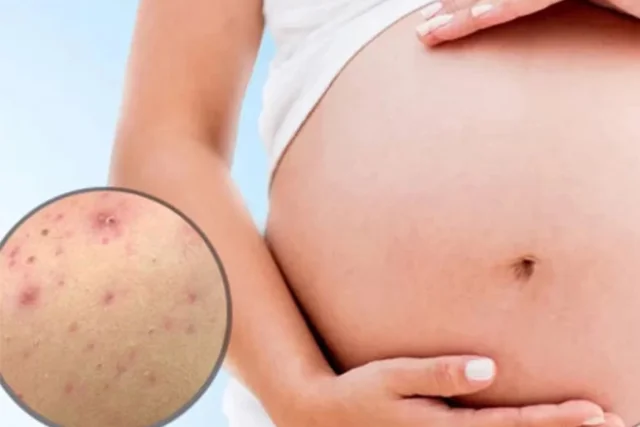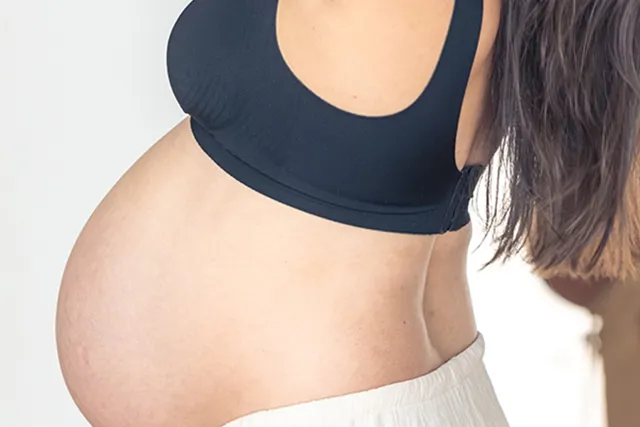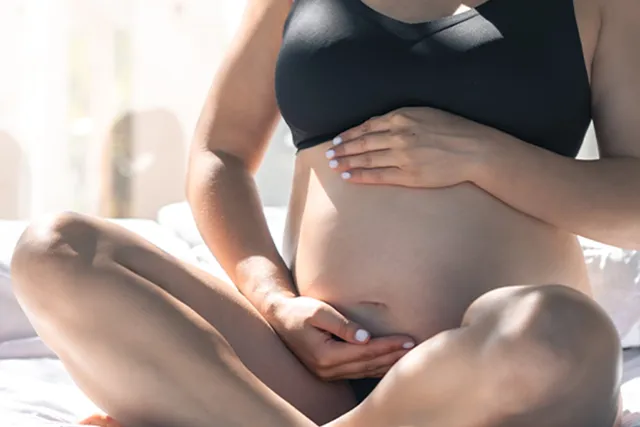Most pregnant women experience skin issues such as stretch marks, rough skin, rashes, or urticaria. Acne is also common during pregnancy and can develop anywhere there are active sebaceous glands—especially on shoulders, chest, and notably, the back.
Back acne during pregnancy often clears up naturally within a few months after childbirth without treatment. However, when it becomes severe, pregnant women may still need supportive measures.
Back Acne During Pregnancy
1. What Does Acne Look Like in Pregnant Women?
Pruritic papular eruptions during pregnancy are characterized by itchy rash and visible spots on the skin. These typically appear during the second or third trimester and can cause discomfort and self-consciousness in social settings. Nevertheless, they are not serious medical conditions.
Affected skin may show:
Persistent itching
Fragile itchy spots, which can scale
Scar-like raised spots or small pimples
Red, pink, or purplish discoloration
Usually clustered together.
2. Causes of Pregnancy Acne
Pregnant women often experience heightened emotional sensitivity and worry about any skin changes. To address back acne safely during pregnancy, it’s important to understand its underlying causes:
2.1. Hormonal Changes
In the first and mid‑trimesters, elevated hormone levels stimulate the sebaceous glands, leading to excess oil production. Clogged pores filled with debris, dead skin cells, and bacteria follow suit.
2.2. Poor Back Hygiene
The back is a difficult area to cleanse, and many antenatal skincare products neglect this part of the body.
2.3. Weakened Immune System
Pregnancy-induced immune changes reduce skin defense, making it easier for bacteria and fungi to thrive.
2.4. Diet and Lifestyle
Consuming spicy, oily foods with minimal vegetables, compounded by stress, sleep deprivation, and lack of relaxation, can aggravate skin health and trigger acne.
2.5. Cosmetic Products
Some creams and lotions can clog pores and promote sebaceous buildup.
2.6. Excessive Sweating
Heavy perspiration combined with tight clothing encourages bacterial growth and breakouts.
Back Acne During Pregnancy
3. When Is Pregnancy Acne a Sign of Skin Conditions?
If accompanied by itching and rashes, back acne may indicate the following dermatological issues:
3.1. Prickly Heat (Miliaria)
Tiny, itchy bumps often appear in hot or humid conditions.
3.2. Folliculitis
Inflammation of hair follicles leading to blisters, commonly seen on the upper back, chest, abdomen, shoulders, and arms—especially in the third trimester.
3.3. Bullous Dermatosis of Pregnancy
Mild blistering eruptions near the thighs and navel that may spread to the abdomen, hands, and feet, typically emerging after week 20.
Back Acne During Pregnancy
4. Does Pregnancy-Related Acne Affect the Baby?
Generally, hormone-driven acne does not impact fetal development. However, pregnant women should treat acne carefully: avoid antibiotics, inappropriate cosmetics, or unverified tips that may harm both mother and baby. Avoid scratching blisters to prevent infection and complications.
5. 5 Natural Remedies for Back Acne During Pregnancy
While topical medications might work, the safest approach for pregnant women is to use natural remedies. Here are five home-based solutions:
5.1. Lemon Treatment
Lemons contain citric acid and antioxidants, which exfoliate impurities and help reduce post-acne pigmentation while brightening skin.
How to use:
Cleanse gently with mild soap or shower gel.
Apply lemon juice to affected areas.
Massage for 10 minutes, then rinse with warm water.
5.2. Cinnamon and Honey Mask
Honey offers antibacterial properties, and combined with cinnamon, the blend effectively treats inflamed follicles.
How to use:
Mix honey and cinnamon at a 2:1 ratio into a paste.
Apply to back acne.
Leave for 30 minutes, then rinse with warm water.
5.3. Apple Cider Vinegar Spray
Apple cider vinegar contains acetic, citric, and lactic acids—effective against acne-causing bacteria. It balances pH and is gentle on skin.
How to use:
Dilute vinegar with water (ratio 1:2) then pour into a spray bottle for easy application.
Spray on affected areas while showering.
Let it sit for 20 minutes before rinsing.
5.4. Oatmeal and Cucumber Mask
Oatmeal is soothing and cleansing, while cucumber hydrates and cools skin.
How to use:
Mix cucumber juice with oatmeal into a thick paste.
Apply on back during shower.
Leave for 10 minutes, then rinse with warm water.
5.5. Medications Safe During Pregnancy
Only use topical antibiotics like clindamycin (Clindagel, Cleocin T) or erythromycin (Erygel) under professional advice. However, dermatological consultation is safest—avoid self-prescribing any acne medications without guidance.
Back Acne During Pregnancy
Conclusion
Although back acne doesn’t affect pregnancy health, it can harm a mother’s self-confidence. Significant improvement is possible using the natural methods discussed—skin protection, dietary adjustments, and safe acne products.
Website: https://wilimedia.co
Fanpage: https://www.facebook.com/wilimediaen
Email: support@wilimedia.co
